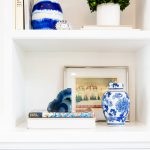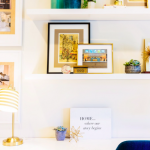A Complete Guide On How To Create Your Dream Home Office
-
Lifestyle
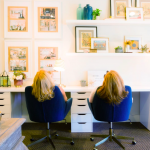
Courtney Thomas is the founder behind her namesake company, Courtney Thomas Design–an interior design firm based in La Canada, CA known for its stunning aesthetic. In this competitive market, Courtney Thomas
When designing a home office, what elements do you include to create both a functional, yet beautiful space?
- Window treatments. Home offices can get weighed down with heavy furniture pieces. Window treatments are that final touch that softens the space.
- Natural light. If I get to help select the office location, I look for natural light and a view. For me, function suffers in dark, closed-off spaces.
- Focal wall. A focal wall, a conversation starter. Something that draws you in and sparks inspiration.
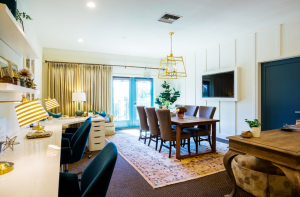
Any tricks for making things look organized and put-together?
- Take outlet location into consideration when you plan your layout. A floating desk might be a great visual in a large space, but where will items you use on it get plugged in?
- Hide the cords! Add grommet holes to wall cabinetry and zip-tie loose cords between walls and desks.
- Stay on top of filing. I am pointing a finger at myself right now. I am the worst at this, but if I take 15 minutes each day to sort paper into files, my brain feels cleaner when I come back to my desk. This is also true for all e-communication. Just because you don’t see the physical paper doesn’t mean it isn’t gumming up your computer’s brain. Delete it if you don’t need it or sort it so it isn’t another document on your desktop.
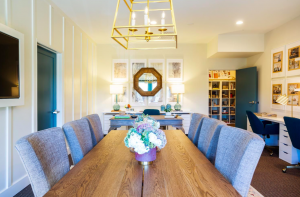
Are there any specific colors or patterns you suggest including in a home office space? If so, what are your favorites?
I like a calming and inspirational workspace. I’m more likely to pick a neutral wall color with splashes of accent colors than go bright red everywhere. I won’t overwhelm walls with lots of busy patterns that could distract focus, but I might add a bold patterned area rug for interest, graphic art on the wall for inspiration and play up architectural details if they exist or add them if they don’t. To me, it’s less about what patterns and color to use or avoid and more about how much and where. I love pattern and lots of color, but I also like balance.
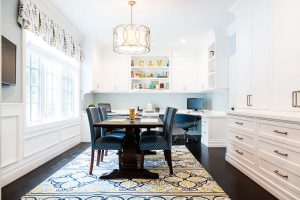
What are your tips for creating inspiration in the office?
- Home offices are extremely personal spaces; more so than the rest of your house. It’s often one of the few spaces in the home that doesn’t have to be shared with family and it’s where you will spend a lot of time tapping into the wells of willpower to get work done. The office should reflect your personality, passions and pursuits. Surround yourself with the things that remind you of why you do what you do and what makes it worth it: family photos, the kid’s school art, framed quotes from favorite authors or color photos from completed projects. If it’s pattern that drives you, build it into the design vision. If you love bold colors, dedicate a focal wall to it.
- It’s entirely cheesy but I keep a photo of me from preschool on a shelf in my office. I am often my own worst critic and when the doubts and criticism are at their worst that photo reminds me to take it easy for her sake.
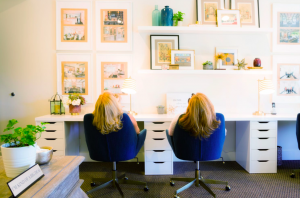
Do you recommend having a lot of lighting in the home office?
Layout and lighting would probably be my top two priorities in designing an office. “Does the desk have to face a wall?” and “What are my light sources?” would be my two first questions. I plan for both general and task lighting. Depending on the work you do, you may need more of one than the other, but work stations like desks, reading chairs or conference tables will determine where task lighting will go. Access to natural light will determine how many overhead lights to include. If a light can combine tasks, all the better. Put a pendant light in front of a window for drama and added ambient lighting. Add wall sconces over a work station instead of a table lamp. It will give you the task lighting you need, more table sprawl and added visual interest.
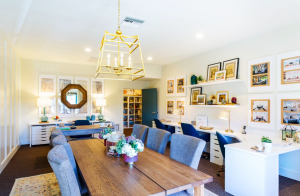
Any other tips on designing a productive and chic home workspace?
- If you have the space for multiple workstations in your office, add them. It can be a club chair in front of a window, a standing desk on an open wall or a large conference table floating in the middle. My productivity increases when I’m not tied to one location. Large tables are great for spreading out if you need to see multiple papers at once. A club chair is great for catching up on work reading and a standing desk can be a great way to return afternoon correspondence without falling asleep.
- Add some audio. Music can be a great motivator and some just like to keep the radio on for background noise.
- Update the art frames. The quote inside won’t be changed just because the frame is. Re-frame all your inspirational pieces in frames that are relevant to the space, in color and style.
